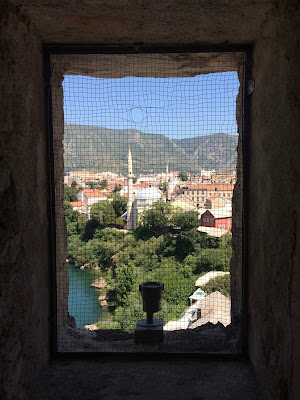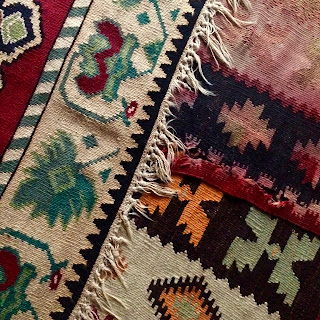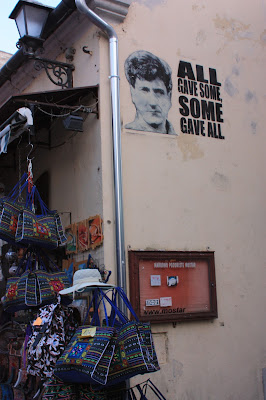While there are countless benefits that I could go on and on about to traveling alone (and probably will soon), I briefly encountered one negative aspect during the first leg of my trip.
I'd researched all different tours that I was hoping to book, but when I finally went to book them I couldn't- they required you to sign up with at least two people! I was really bummed at first, but it ended up being a blessing, as what I did find was a million times better.
In a previous post I commented on the exceptional hospitality at my hotel; when I asked about tours outside of the city at the front desk early my first morning, I thought I was out of luck. I'd waited too long and hadn't planned ahead. But I was told that calls would be made, and they'd find me a tour- and they did! One of the manager's also ran Airbnb's with his girlfriend, and she was taking a couple out the next day!
In a previous post I commented on the exceptional hospitality at my hotel; when I asked about tours outside of the city at the front desk early my first morning, I thought I was out of luck. I'd waited too long and hadn't planned ahead. But I was told that calls would be made, and they'd find me a tour- and they did! One of the manager's also ran Airbnb's with his girlfriend, and she was taking a couple out the next day!
 I woke up that morning ready for action, repeatedly telling myself that spending the day with strangers was definitely something I could handle. As we made our way to the first stop, our guide (I'm going to call her A) filled us in on some of the major points of Bosnian history, especially focusing on the most recent war for independence. Hearing it from someone who had been born in the midst of it was heartbreaking. I won't get into too much for the sake of her privacy, but her perspective was honest, thoughtful, and open-minded.
I woke up that morning ready for action, repeatedly telling myself that spending the day with strangers was definitely something I could handle. As we made our way to the first stop, our guide (I'm going to call her A) filled us in on some of the major points of Bosnian history, especially focusing on the most recent war for independence. Hearing it from someone who had been born in the midst of it was heartbreaking. I won't get into too much for the sake of her privacy, but her perspective was honest, thoughtful, and open-minded. She shared that her high school had been divided between Bosnian and Croatian students.
On student council, she and her friends had tried to encourage the school to mix the students for at least one class, but they remained separated. We learned about her grandma's old stories from the days of Tito, as well as how the war still impacts her life every single day. Though her outlook was positive, it was fascinating (and sad) to hear so directly about life during and after such a terrible time in their history.
 Blagaj Tekke
Blagaj Tekke
Our first stop was at Blagaj Tekke, a Dervish monastery built between 1446 and 1520 along the Buna River. Because it is situated directly next to the cave holding the source of the river, the water is pure enough to drink! Immediately upon stepping out of the car in Blagaj, a sense of peace unfolded around me. The monastery is built at the base of the high cliffs surrounding the river. Though nearly 100 degrees elsewhere, the temperature seems to drop the closer you get, making it cool and comfortable.
Though a major tourist attraction for the area, the Tekke is still a holy place. Before entering we were required to remove our shoes and cover ourselves. There were long wraps to cover our legs (for both men and women), and scarves to cover our hair (women only). Walking through the serene building feels like you're in on a secret; the prayer rooms aren't always in use, but they were during our visit. I felt like we were tip-toeing around something very private, though as I mentioned, it is a tourist destination. The rooms are decorated with the typical Ottoman rugs, and hold volumes of religious texts.
 Pocitelj
Pocitelj
Our second stop was at Pocitelj. During the middle ages, Pocitelj was the center of administration and governance for its county, and was supposedly built by Bosnia's King Stjepan Tvtko in 1383. What makes Pocitelj especially special is its architecture mixture of medieval and Ottoman. Between the 14th and 18th centuries, the city was ruled by the Hungarian empire, the Ottoman Empire, the Austro-Hungarian empire. The architecture of an old rule is often destroyed to make room for the new, but in Pocitelj, you can see elements of all clearly, as it was well preserved. Because of this, Pocitelj is on UNESCO's Tentative List for classification as a World Heritage Site.
Perhaps because it was so hot, we were some of the very few visitors to the small city, and at certain points the only at the citadel. While the hike up the uneven, slippery stairs was a struggle, the view was lovely, and you probably know how I feel about ruins by this point (hint: I love them). A told us about the history of the town, as well as the 1992 bombing that nearly destroyed the city, and landed it on World Monuments Watch's 100 Most Endangered Cultural Heritage Sites list in 1996 and 1998. After our hike up to the top, we treated ourselves to ice-cold pomegranate juice and little cones full of fruit on the way out of town.
 Kravice Falls
Kravice Falls
The final stop was the one I was most excited for: Kravice Falls. The falls consist of a lake surrounded by about 20 waterfalls, some over 80ft tall. Most importantly, YOU CAN SWIM THERE!!! After a steamy day of climbing fortresses, nothing felt better than jumping into the water and scaling up the rocks to get right under those falls. It was a great bonding experience for me and the other tour-ees (though they were a couple, and there's a chance that I was a huge imposition...), and A later told us that she was terrified watching us climb around like little mountain goats the whole time.
As a longtime waterfall-calendar enthusiast, I was basically in heaven the entire visit. The falls themselves are hugely impressive; nature is truly incredible. I may have bought a waterproof phone case specifically for this visit; though I have never been a selfie person, I probably took 800 on this vacation... oops :) In addition to swimming, climbing, and taking pictures there were some brave souls who we also watched jumping off the falls into the water below. How they managed to miss the rocks and shallow parts, I'll never know, but I was only courageous enough to watch.
As a longtime waterfall-calendar enthusiast, I was basically in heaven the entire visit. The falls themselves are hugely impressive; nature is truly incredible. I may have bought a waterproof phone case specifically for this visit; though I have never been a selfie person, I probably took 800 on this vacation... oops :) In addition to swimming, climbing, and taking pictures there were some brave souls who we also watched jumping off the falls into the water below. How they managed to miss the rocks and shallow parts, I'll never know, but I was only courageous enough to watch.
While swimming, we met two Americans who shared that they were traveling and playing at different venues around Europe. I intended to go and watch that evening, but without internet access, I didn't think I'd have a great chance of finding it. Well, on my way out for one last exploration of the city that night, I heard some great music coming from near the Crooked Bridge (another cute Mostar bridge). As I got closer, I recognized the name of the bar not only from one of my favorite songs, but also from my earlier conversation: Black Dog Pub. Drawn by the music, I headed in and saw one of the guys I'd met playing along with what turned out to be a Serbian wedding band! Unfortunately, my new friends had been double booked, but lucky for me I got to hear not one but TWO awesome bands play. There was some additional craziness of the night, including finding the worlds cutest kitten, being aggressively invited to breakfast by a homeless man, and finding a ride for the next day to Croatia. Overall, that day exploring Herzegovina was one of the most interesting days I've ever had!























































